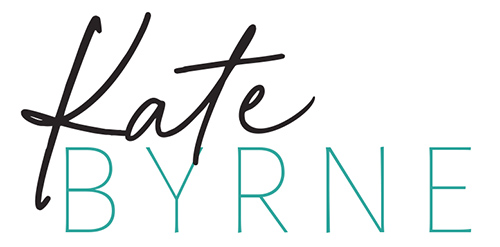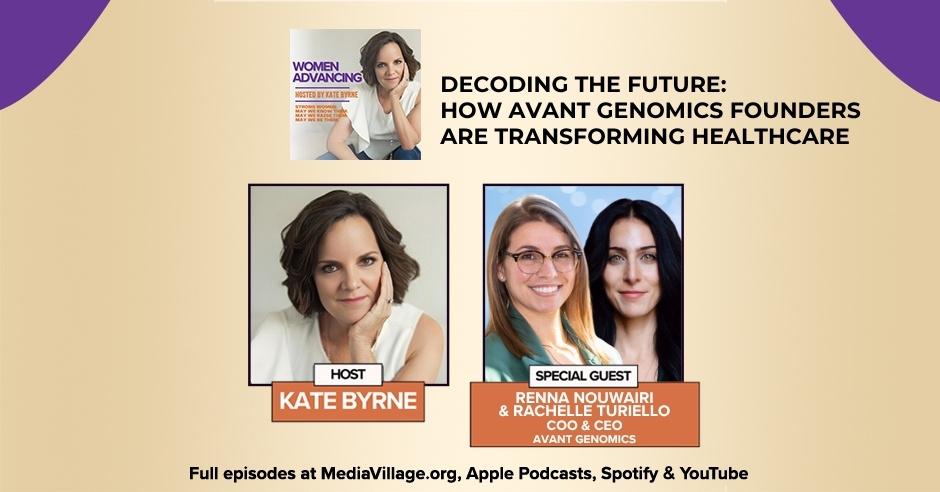
Revolutionizing blood collection isn’t just a technical breakthrough — it’s a lifeline for millions navigating cancer care. Rachelle Turiello, CEO, and Renna Nouwairi, COO of Avant Genomics, share how they are building a technology that improves DNA preparation, strengthens the accuracy of liquid biopsy testing, and makes early detection and treatment monitoring more accessible for patients. From their unexpected partnership in the lab to co-founding a biotech startup during pregnancy, their story blends hard science with human empathy, resilience, and purpose. This conversation uncovers the courage it takes to disrupt healthcare, the discipline required to listen to patients and partners, and the vision driving two women to transform what personalized medicine can mean for families worldwide.
—
Watch the episode here
Listen to the podcast here
Decoding The Future: How Avant Genomics Founders, CEO Rachelle Turiello And COO Renna Nouwairi, Are Transforming Healthcare
Avant Genomics Is Rewriting The Script On Science And Accessibility
Many of us have been touched by cancer, either through surviving it ourselves or having loved ones who have battled and passed from it. It’s so frustrating when you watch someone who you want to get the fastest ultimate care, and because of inaccessibility and the slow pace of said care, nothing ends up being able to be done.
Enter our guests, because what happens when two visionary scientists decide that the future of medicine shouldn’t just be about faster data, but actually smarter, more human-centered care, and frankly, more accessible and accurate? You get Avant Genomics, which is co-founded by the CEO, Rachelle Turiello, and the co-founder, Renna Nouwairi. These two are amazing. They’re on a mission to transform how we understand genomics, moving beyond the lab bench and into real-world impact in healthcare, equity, and actual innovation.
We talk about a number of different things. We talk a bit about genomics, so you’ll get a better understanding of what is going on and what is one of the most exciting and disruptive frontiers, but the lessons and courage it requires to launch a startup in a field that’s moving at a speed that’s beyond discovery. These two ladies are so out over their skis, but they’re doing it with great relish. That is amazing.
We’re going to delve into their partnership and what the secret sauce is, self-respect and self-awareness. As a result, it fuels their resilience, their creativity, and their trust, and how, in this day and age, we need to balance hard science and human empathy. Data alone doesn’t do much to help the people that it’s meant to serve. We’ll share a little bit about what they wish they’d known at the beginning of their journey and the advice that they give as well.
I’m sure we’re going to talk a little bit about science. We’re going to talk a lot about being a founder and courage in the future. We’re going to talk primarily and do a real look at how two women are pushing the boundaries of genomics while staying anchored in purpose. Let’s dive in. Stay to the end for my KB takeaways.
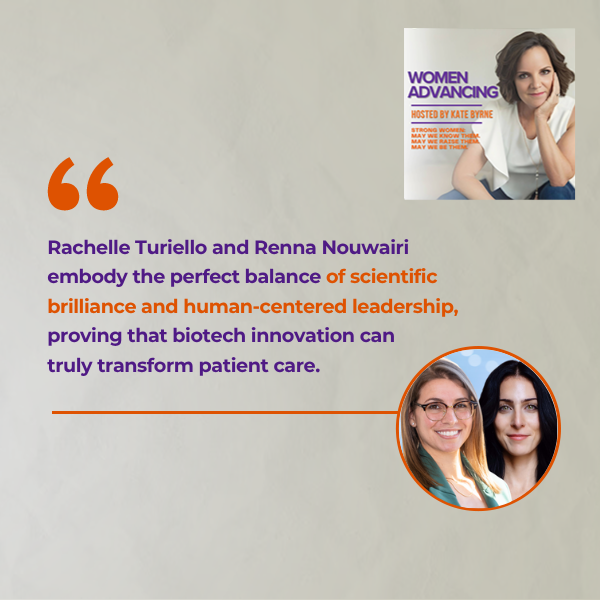
Women Advancing readers, welcome. I am excited to connect because I get to connect you with two amazing co-founders of a biotech company that’s going to change the world as we know it. We get to sit down with Rachelle Turiello, who’s the CEO and co-founder of Avant Genomics, and Renna Nouwairi, who’s the COO and co-founder of Avant Genomics. Ladies, welcome to Women Advancing.
Hi, Kate. Thank you so much for having us.
We’re very excited.
The Genesis Of Avant Genomics: Filling A Critical Gap
Your story is so terrific. I want you to dive in because of what these two are doing. Yes, the work itself is important, but even the fact that we’ve got two women who are leading and successfully doing so in such a competitive and male-heavy field, there is so much to share, so do. What inspired you all to create Avant Genomics? What gap in the field did you see that you said, “We’re the ones to fill it?”
It was organic and a long and winding road. Interestingly, I spent over a decade working in forensics before jumping into cancer diagnostics. I was working on crime scenes and identifying victims and suspects from DNA for multiple police departments in Maryland. What’s interesting about forensics, too, is that it’s a very female-dominated field.
Is it?
Yes. Most of the people that I’ve worked with in my career in forensics in the past were women. I guess we can handle the nitty-gritty, gruesome stuff.
Forensics is a very female-dominated field. Share on XWe can also find the nuance, have the patience, and get people to spill the tea as we see.
While I was doing that, I was also teaching in a Master’s program. I was teaching Forensic Science. I was going to a lot of conferences. I was staying current with new and cutting-edge technology. I was constantly struck by how difficult it was to implement new technology that we were seeing in academia and at conferences into the lab. This should tell you a lot about my personality. I was frustrated enough that I decided to take a hiatus entirely. I left my job. I sold my home in Baltimore.
I started my PhD in a lab where the team was well-known for not only developing new tech for labs that could be more easily implemented into labs, but also known for plugging in with government and industry to get it into the hands of the people who were doing this work, so boots on the ground. The hitch in this giddy-up, though, was that this lab happened to be in a Chemistry Department. I did not, at the time, consider myself a chemist. My training was in genetics and anthropology. I needed a buddy. There needed to be a buddy system for me to make it through this program. Maybe I could impart some knowledge on them, and they could impart some on me. Luckily, I picked an empty desk right behind Renna.
Rach comes in. She sits behind me, looking fabulous as always, and has all this experience in the field. I had come from undergrad in Chemistry. I taught at a private high school for a little while, in Chemistry, Physics, and Robotics, so very core sciences. My background was more in chemistry, physics, and math of everything. We very quickly found that we had complementary strengths, where Rachelle was the applied chemistry side of the genetics, biology, and forensics. I was a little bit more focused on the physics that explains why the chemistry happens. We ended up teaching each other as we went through qualifying exams and filling in each other’s gaps in knowledge.
Did we become best friends?
Absolutely.
That first year, I wrote an application to the DOJ National Institute of Justice. I said, “I want to solve this problem. I want to develop a solution for what I viewed in the field and in the lab as the most difficult part of any of these genetic workflows, which is sample preparation.” It’s dozens and dozens of steps. It’s manually done. Reproducibility is poor, your ability to get the same result from sample to sample. In that process, you can lose 95% of the DNA.
In forensics, you get these little amounts of DNA. Sometimes, it’s the interaction of touching someone. We’re getting DNA from that interaction. If you lose much of that DNA, you’re not going to get a good result on the backend. I wrote this application. It’s some very low statistical result that you’ll actually get funded. I was absolutely shocked that we were funded. We start working on this project. A few years pass, and it’s going well. We’re presenting this work at a conference in Croatia. We’re up for an award. This conference is staggeringly cool. It’s nothing we’ve seen in the US. It’s split between personalized medicine and forensics, anything cool you can do with DNA.
It’s all the thought leaders from Mayo Clinic and all the heads of government agencies in Europe that are equivalent to our FBI, Department of Defense, and Department of Justice. The Minister of Health was there for Croatia. He was the one presenting the awards.
We got the award, by the way.
That was a fantastic conference that was focused on how genetics and all these different applied biological fields can come together to help with personalized medicine and forensic science.
Renna and I are absolutely in awe of all these people. Sitting in the audience, we took some chairs and faced them toward ourselves. We got a big pot of tea. We put our feet up. It was pretty funny. We listened to these people talk about this insane work that they were doing. We started to see a theme, which was that each of them was working hard on the backend of their process to solve for this low-level DNA or contaminated DNA that they had with clever detection methods and with backend algorithms. They were still having a hard time getting good results.
We were like, “We’re seeing a theme here, which is all of them are using the same antiquated separation or DNA preparation process that we’re trying to solve for in forensics. This could be hugely impactful and personalized medicine.” That night, we went to dinner with our husbands. We’re recapping on the week and all of the talks that we’ve seen. Our husbands passenger-princessed with us during this conference, to have an excuse to go to Croatia. We decided we were going to start a company. Everybody got on the same page. To consummate our union, we jumped into the Adriatic Sea together. That was very much our a-ha moment. This could be impactful. We brought it up that it’s happening.
All of them are using the same kind of antiquated separation or DNA preparation process that we're trying to solve for in forensic. Share on XIt could be a company. They’re there. It’s a combination of things. It wasn’t a pivot. It was a fine-tuning. It is looking at it through that lens, which is the bigger entry point.
It was problem-focused. We were sitting there listening to people who are like, “We’re having this problem. Here’s how we’re trying to solve it.” We were like, “It feels like you’re missing this whole component. That’s being taken for granted that we’ve spent so long working on.” We realized, “We could help them solve this problem.”
I love that. That’s what we’ve been doing. Yes, it was an a-ha, but I’m sure it was also, “We’ve been doing all this work. It’s not all for naught.”
As we came off stage, people were coming up and asking, “Can we get this technology? Can we buy it? Can we set up a collaboration?” They wanted it in their labs, whether it was an academic lab or in different countries. Forensic labs wanted to try it out in their labs. It was like, “This is something that could go somewhere. We should look into this.”
The beauty of that, too, is that you’ve got your audience, the community they’re building. You’re going to probably get real-time feedback going. “Man, you were close on this, but what would be great is this.” It also helps you. We were talking a little bit earlier about Gantt charts, timelines, and milestones. That then helps you figure out everything. Which features should come first? So often, if we’re not exactly in a field, we have an idea, “We should do this, this, this,” but when you hear from the audience, it is like, “We so don’t care about that,” or “Yes, that’s a nice to have. It’s not a must-have.”
Those customer conversations are always happening.
Is it hard to listen to them sometimes when you’re thinking, “Yes, I know, but we want to do this one.”
It’s been a bit of a mind shift. Coming from academia, we do science because it’s exciting. We want to see how far we can push the boundaries. That’s not always what people in the industry want. They want something reliable, consistent, and that they can use easily. It is having to shift from a “This is cool technology. We can make it go faster and be better,” and having to step back and say, “Maybe we just need it to be solid, reliable, and good enough to work. That’s what the customer wants.”
Transforming Cancer Care: The Real-World Impact Of Liquid Biopsy
With all that, which is awesome, what is the most exciting about the real-world application of what you’re doing from either the patient or practitioner, or the entire care system realms?
As we illustrated at the conference and understood all the way back then, these companies are working hard to do exactly what we saw. Build clever algorithms to detect cancer from large volumes of blood. They forget that their ability to detect with high confidence is hinging on how well their preparation performs.
It’s all about the quality of the DNA going into the reaction.
Garbage in, garbage out.
Exactly. If we can fix a problem like this, where a system uses every little bit of sample, the likelihood of success increases dramatically. When we zoom way out and think about this field, liquid biopsy, and detecting cancer from blood, we think about a couple of different use cases. We’re thinking about early detection. We’re thinking about therapy selection, using your own genome from that tumor to determine which therapy will work best for you.
We’re thinking about therapeutic monitoring and minimal residual disease testing. By that, I mean post-tumor resection, monitoring that patient throughout their entire oncology journey to ensure that nothing new has emerged or that this one is subsiding. All of these are stemming from the same basic principles of garbage in, garbage out, as you were saying. If we zoom way out again, and we do a good job of putting higher quality material in to get better results, what this leads to is more FDA approvals because tests become more reliable. More reimbursement structures are being put into place for these tests. Ultimately, more doctors will offer these tests to patients.
More patients are able to take advantage of the benefit of having tests like these to monitor them throughout their journey, as opposed to waiting every few months for a scan. They can get constant blood tests and have personalized, individualized care delivered to them in a structure that supports that. That’s starting to emerge, but it’s slow going. If you look at the criticisms of liquid biopsy, there’s so much potential and so much promise. For patients, it hasn’t been able to come to fruition in a lot of different ways.
It’s starting to, and that’s exciting. We’re seeing this a lot on the therapeutic side now, but it’s the implications of something like early detection. Colorectal cancer is one example. Fifty million people a year in the screening age range don’t get screened either because they don’t have access to a colonoscopy, or they can’t get into a GI clinic. It’s the standard of care. Colonoscopy is fantastic, but what are those other 50 million people going to do? You have to get it. If they can even have an interim test that has high enough sensitivity to give them some level of confidence that they can wait those nine months for a colonoscopy, that’s worth it in our minds.
We love how translational this technology is and how it’s impactful, not just for the people in the lab who are running the tests, but for the patients, our family members, and everyone we know who is affected by cancer.
You mentioned family members. Have your family members had interactions with cancer or had to deal with it?
Yes. My stepfather has stage four disease. It started as esophageal and has become stage four liver. That happened very quickly. It started one day with, “I can’t swallow.” It took eight weeks for him to get in and get scoped. During that whole time, he’s been having difficulty getting food down. He’s losing weight. The worst thing you can do is lose weight and lose strength when you’re going through something like that, chemo radiation, and then these three months of scan intervals.
In between those scans, he developed stage four metastatic disease in another organ. It wasn’t caught during the early scans. We do show that people with advanced cancers who are using liquid biopsy to monitor during treatment can live twice as long because you’re catching these things earlier than you would otherwise. He’s at some well-regarded hospitals right now. At no point was he offered that intervention. It’s a shame. That should be on the list of things that you can try that are at your disposal before you’re dealing with stage four disease. Maybe it could be impactful for some patients. This study shows that it is.
The unfortunate reality is that one in two people is going to be affected by cancer now. We all know somebody who has had cancer or will develop it in the future. That’s unfortunate. Something needs to change in the standard of care.
The unfortunate reality is that one in two people will be affected by cancer. Share on XThirty-five million people are in active treatment every year.
A Personal Connection: The Human Side Of Genomic Research
To your point, I don’t know that the general public, or a lot of people, understand that what starts as one form, as is the case with your stepfather, is metastatic. It shifts and changes. Sometimes, what it started isn’t the type or the place where it actually eventually gets you. I know this from my mom, my dad, and my longtime friend with pancreatic cancer. The thing that’s so beautiful about this, too, is it’s double A. It’s the accuracy, and it’s the accessibility. When you’re in that situation, especially, and I know a lot of readers have been on the caretaker side, your hands are tied. You can do so little. To your point, you’re watching this person melt in front of you. Everything that goes on inside mentally, spiritually, and all of that, is so hindered by anything.
It’s not the doctor’s fault.
No. That’s the thing. It is nobody’s fault.
They’re overburdened. They’re understaffed. There are too many people who need treatment on a regular basis to keep up. Going back to the colorectal cancer example, if all 50 million people who don’t get screened for colorectal cancer suddenly decided to get screened, the waitlist would be ten years long, because there are not enough physicians to do all of that work. Having a blood test, instead of having to take up time in a clinic or surgery, would be so much more efficient and practical.
It’s about diversifying the options. The argument is that sometimes, for colorectal, in particular, getting a scope is the standard of care. It’s going to be the best option because we can visualize polyps. Of course, it is, but not everyone is going to have access to that. If we’re talking about early detection, that’s the argument. If we’re talking about monitoring, this is the intelligent approach. We have the ability to personalize medicine at this point to select therapies for people that will work well for them and give them longer to live. Why not include that as the standard of care? Yes, there are some barriers. We need to get the performance up, but that’s part of what we’re working so hard to do.
The goal is not to replace the standard of care. It’s to be another tool in a toolkit, so it’s more accessible and people have options.
Navigating Challenges: Funding, Scaling, And Market Evolution
Dare I say, enhance and empower the standard of care. It’s evolution, which we all know needs to happen. On the company side, what has been the hardest challenge so far? Is it funding? Is it science or scaling? Is there something else? How do you navigate it?
It’s that this market is new and emerging. It’s still shaping itself. It requires us to be vigilant about staying on top of what is coming out in literature. What are the new methods undergoing FDA approval? What are the new developments in the field? The constant learning is a challenge, one that we’re well-suited for. We love that aspect of the job, but we do have to carve out a lot of space for that to stay on top of everything. It also leads to a challenge in funding because we’re building a very technical product with a huge market potential. Figuring out who the right partners are to tell our story and who’s going to understand our story is difficult.
Who is going to be committed to performance? It doesn’t have to be perfect before we roll it out, but we are, in our heart of hearts, analytical chemists. We want to make sure that whoever we partner with is aligned with our vision for delivering this to be an impactful technology and not just another one that’s on the market competing with the current standard.
That translates into having patient capital, not having this be opportunistic, but to have the ability to give it the time, the space, and the cycle to develop, and both understanding that it’s not a failure, but a learning. Isn’t that just that? It’s not a failure. It’s actually helping you get closer, closer, closer rather than, “We’re going to expect it to hit this number or hit this. If it doesn’t, it means you’re on the wrong track.”
It is the constant cycle of something didn’t work out. We have to pivot, but we are excited about the pivot, learning, and achieving.
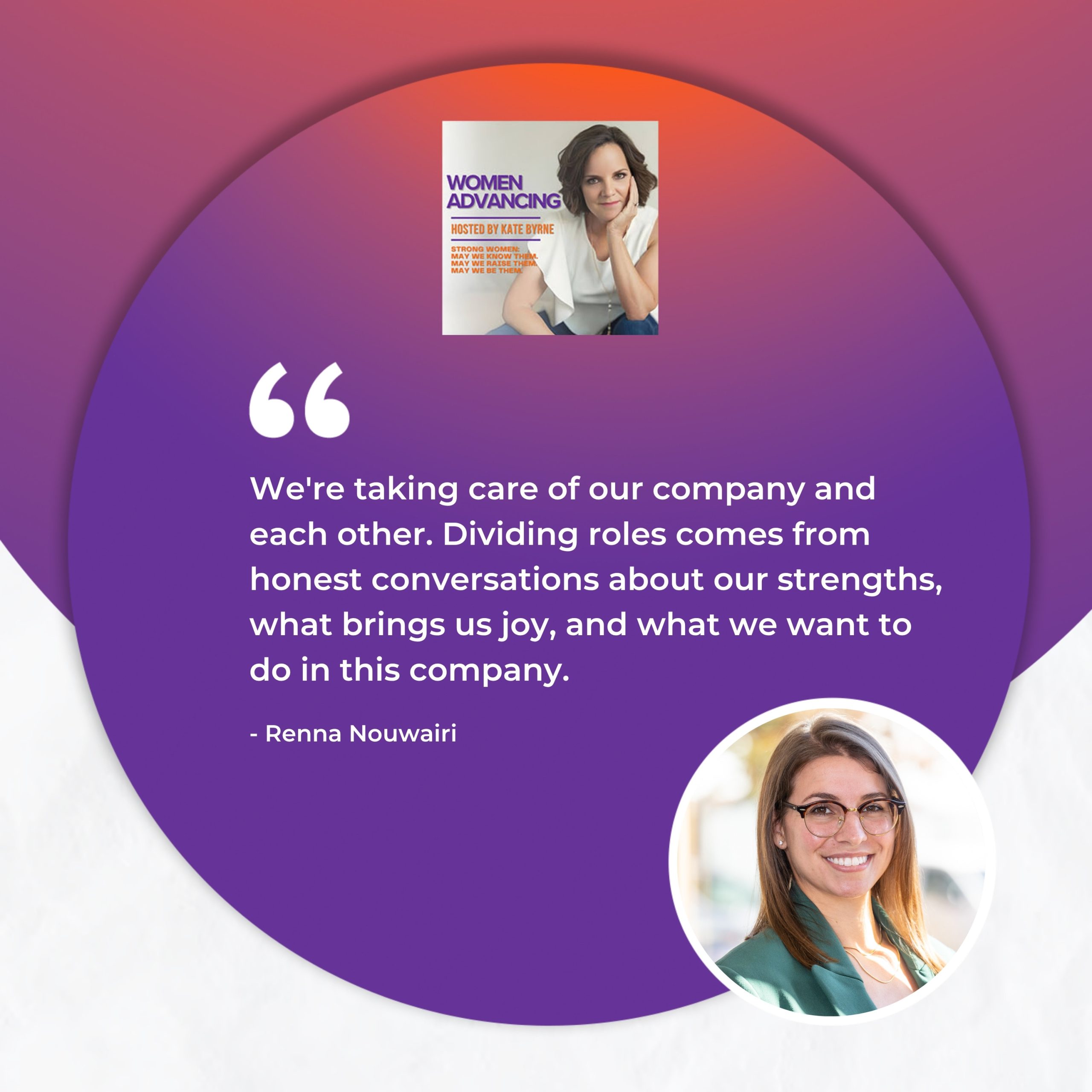
That’s why we’re good scientists.
I think so, too.
It’s constant learning from mistakes and failures.
This is part of the issue that I have. Don’t get me wrong, those of you who are on the finance, money, and investing side of things. To me, that’s part of the friction that continues to happen, with either being a technology, but particularly in biotech, anything science-oriented. There are so many things or unknowns that we don’t know, but the money side of the house needs it to be, “I want a guaranteed return.” “I know there’s no guarantee,” but they expect a guarantee.
The short side of that is the founder of the company, when you come up and say, “We’re thinking it’s going to be this. It’s our hypothesis. We’re thinking it should look like this.” When it doesn’t, it’s like, “It didn’t. You’re losers.” The whole system is changing and shifting. It’s about to happen because there are going to be things like quantum physics, quantum anything, or quantum computing. It’s going to demand that and shake that all to its knees.
What that translates into for us, and in terms of funding and then commercialization, capitalizing and commercializing, is breaking things up into very clean milestones because, in the past life, our tendency would be to work on everything and make every aspect perfect, and how it all integrates. On a grand scale, that’s what we’re working to do over time. In business, that’s not possible. There needs to be these bite-sized deliverables that people can chew on that will continue to infuse value back into the company and also keep our customers engaged with the product and with us. It does work out. It was a learning curve in the beginning. It’s still a learning curve for being totally honest.
The Power Of Partnership: Building A Strong Co-Founder Team
Continue as the surroundings shift every second. Speaking of shifting, let’s shift a little bit into you, this fabulous co-founder team. Honestly, and we all know this, it’s like a marriage, right?
Yes. We talked about getting a ring.
How do you divide roles, resolve disagreements, and keep this partnership so strong? There’s such a mutual respect that is palpable and a genuine enjoyment of each other. That’s so fun because oftentimes, it can be where someone gets a little green-eyed, as my dad would say, a little jealous of the other. How do you make the magic happen, friends?
You hit on it. It’s respect and trust. The basis of our partnership is that. Just like in a marriage, we give each other feedback regularly. It’s both positive and constructive. We always know that our feedback comes from a place of respect. Egos are never an issue. We both want what’s best for the company and for each other. We’re taking care of our company and taking care of each other.
Dividing roles comes from having those honest conversations about not our strengths, but what brings us joy, and what we want to do in this company. Rachelle is the visionary. She can make these amazing plans and see, “In five years, we’re going to be here.” I have much more of the “I’m going to figure out how to get us there in those small, actionable chunks that we can actually accomplish.”
As I mentioned early on the call, Renna sees things as Gantt charts. Whenever we have to do one of these cyclical, “Let’s go back to the drawing board and figure out if what we’re developing right now is speaking to the customer,” I’m big picture. Renna needs a whiteboard and a marker. She’ll start drawing on her hand if she doesn’t have one ready. There are all these line diagrams. She’s like, “If we did this, then we could do.” My brain can’t operate that way. It’s fantastic that she has the ability to do that. There’s a lot of respect in understanding how the other person’s mind works, what is important to them both personally and professionally, and the role that each one of us plays in our day-to-day and in this great play we call life.
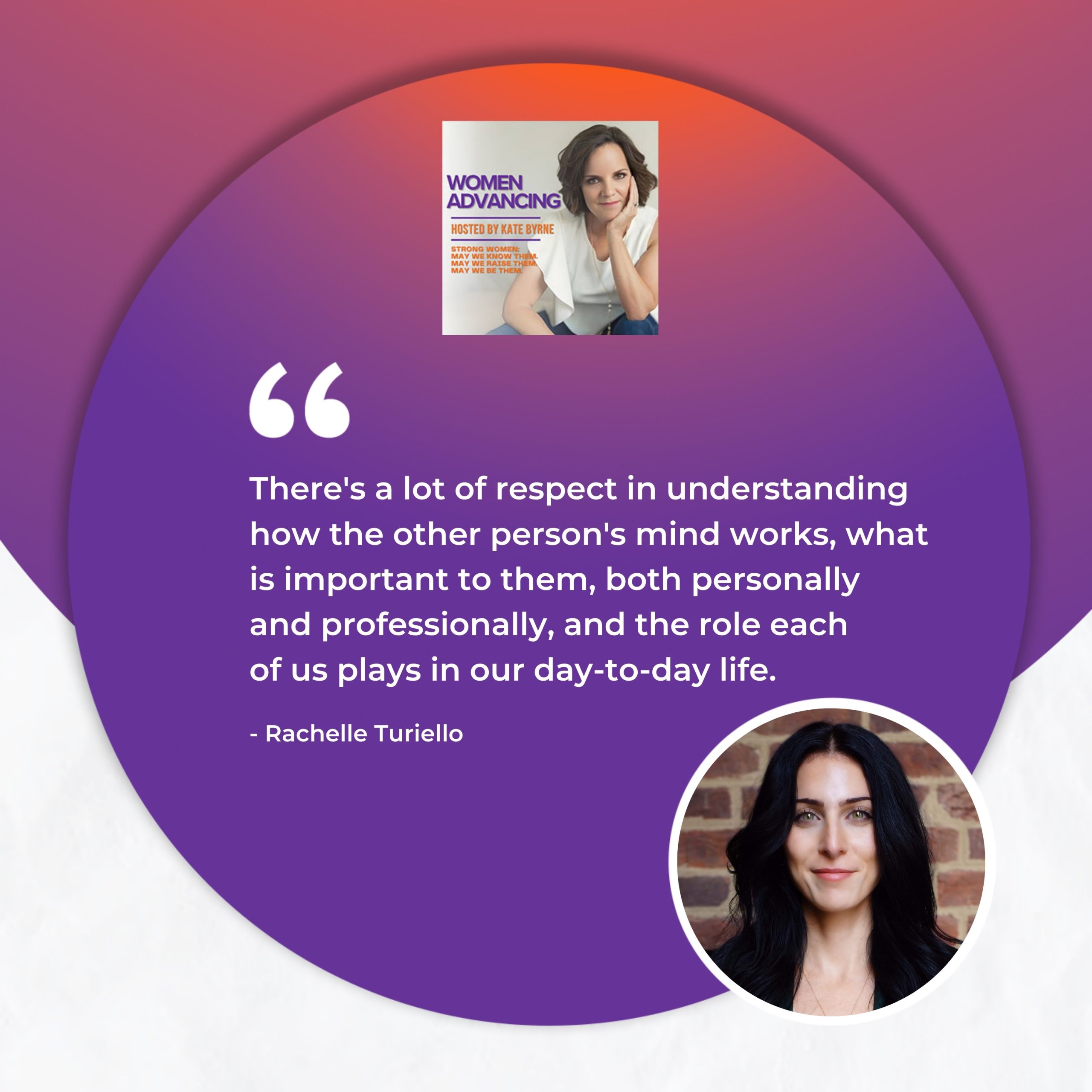
I’m going to say it also requires, and it demonstrates that each of you also has, a deep knowledge of yourselves, self-awareness.
I am working on it all the time.
That won’t change. It continues. Seriously, that is so important. There comes a time when there’s something so much bigger than you. It’s this and what you can leave, the legacy, the shifts, and the dramatic changes that it can bring about for so many gazillions of people, understanding, “I need to let up on this. We’re going to go here.” That is part of your magic as well.
We’ve been working together for a long time. With that, we’re getting to know each other very well. We know each other very well. Sometimes, we know each other better than the other one knows themselves at times. There are times when one of us will come in and we’ll be having a slightly off day. Maybe our daughter was up all night or something. We’re running on fumes. The other will, “Renna, you need a cup of tea, go sit in the sun for ten minutes, and recharge for a second.”
She has to recharge like a lizard or a cat.
Sometimes, I’ll look at Rach and say, “We need a mental break for a little bit. We’re going to go walk around outside for five minutes.” It’s good to know what the other needs and be able to make space for that as well. If there are days when one of us needs to say, “I have to handle something at home,” the other one can step up and say, “No problem. I got you. We’re covered for today.”
It's good to know what the other needs and be able to make space for that as well. Share on XWhen we started this company in March of 2023, I was large and pregnant. In quick succession, so was she. We went through that massive change together as well. There were a lot of responsibilities both at home and at work. We gave each other a lot of grace to grow, learn, and become new people because you do. You emerge as a new person after you have little people. Also, our company was like our little person as well. There’s this huge responsibility to the unit.
We’re still growing and changing with it.
Breaking Barriers: Women Leaders In Biotech
It shows that. I can’t wait to see. As women leaders in this realm of biotech, and the fact that you started this, creating or baking babies who were on the way, if you’re going to be adding new customers, but hopefully, we won’t need to, how have you approached breaking through barriers or biases? I don’t often like to dwell on this, but it does happen.
It’s very relevant. We were discussing this.
We were discussing it because we started seeing an executive coach. This also speaks to the question you asked previously. Renna and I both have a team of people whom we see. We have the same therapist. She’s filled in all the time, a psychiatrist and now an executive coach, whom we’ve been seeing. The topic for me was about exactly this, because both of us have struggled with that, with holding space for other people’s poor behavior to make them feel comfortable and put them at ease. We believe somehow that this would blow over if we let them get away with it, but you’re giving people permission to continue to treat you that way. We were working all the time on not providing space for anyone to treat us poorly, to make little comments.
Minimize what we’re doing or our achievements.
I would offer that they probably don’t even get it. That’s why they’re minimizing it, perhaps. That’s so important. I was learning about this whole new practice of saying, “Let them.” Sometimes, it is so much easier said than done. I went through something like this, which was funny. I thought, “Their need to be right is so important.” You can be right if you need to be, but not at my expense, especially when it’s not right. There’s a decent way of doing it.
It is finding that balance of when it is not okay. When is it not in the interest of our company, our co-workers, our team, or ourselves?
Let them. Let people reveal who they are to you, so you can decide whether or not you want them to be a part of this story and this thing that you’re building. It’s a privilege. Your time is never more important than my time. Your opinion is never more important than my opinion. It’s not that mine is always more important. Why is the assumption that when I walk into a room or when Renna walks into a room, that because we’re female, or maybe younger than some of the other executives, that their time is more valuable or their opinions are more valuable? It’s just not the case.
Let people reveal who they are. Then decide if you want them in your story. Share on XVision For The Future: Avant Genomics’ Impact In Five Years
Why are you meeting me from such a place of a lack of curiosity? Are you such a Yoda that you know it all? I think not. Where do you see Avant Genomics in the next five years? What are some of the big milestones you’re most focused on right now?
It is interacting with customers on a very large scale. I’m very excited to get the technology rolled out and start solving problems for people, and then continuing to solve problems for people, continuing to stay active on the market, and continuing to learn. We could give you some economic answers about where we see Avant in the next five years, but we want to see it be impactful for people. We want to see more laboratories doing liquid biopsy testing because we brought the barrier down to make it part of their capability. We want to see more patients using liquid biopsy as a tool, as opposed to some specialty thing that only a few people have access to because they can afford personalized medicine. We see it as a game-changer in the next five years.
Wisdom For The Next Generation: Advice For Female Founders
Knowing what you know now, what advice would you share with your younger self?
Give yourself grace to mess up. It does not have to be perfect, and it’s not going to be perfect. As long as you’re constantly learning, that’s okay.
During my PhD, I had an incredible female professor. She taught a very difficult class, notoriously difficult. She would send us home with these problem sets. There were these complex problems. Very open-ended answers were expected. I would stay up all night working on these things. I was in the corner of my tiny apartment in Charlottesville and Belmont. I’d sit at this desk and work on these problem sets. There was one problem set in particular that was tough and exciting because it was so tough.
It was the final question. We were up against a deadline. I had written several answers to it. I had several iterations of what I would say, but it wasn’t perfect. It wasn’t the perfect answer in my mind. I deleted the answer, sent it in with no answer to that question, emailed her, and said, “Here’s my problem set.” This was during the pandemic. We were very much virtual at this time. She responded. She said, “It’s very unlike you to leave an answer empty. Can I ask you what happened? Did you have a question?”
I said, “No, I had several answers to this question. I didn’t feel that they were good enough. It felt disrespectful to give you an answer to this question that wasn’t perfect. I submitted it without an answer.” She wrote back this long, beautiful message. She was like, “Send me your answers anyway.” I sent them to her. They were fine, probably. This is when she sent back the long, beautiful message.
It was something to the effect of, “Your male counterpart will not hesitate to send something that isn’t perfect. The problem that you will face is believing that things have to be perfect before you are able to submit them and send them. That will be a huge detriment to you. Many men holding the same accolades that you do will apply to jobs that they are far less qualified for because they believe that they can. You and many other women will not. You need to have the courage to submit it, trust yourself, and know that not everything has to be perfect because you’re competing with other people who are going to send an answer.” That struck me hard. I don’t think I worked at all that day. I ruminated on that. It has changed a lot of interactions for me. It doesn’t need to be perfect. Those initial thoughts that I had were as good as someone else’s answers.
In this field and the level of transformation or tumult that you’re going to be bringing about, that’s going to be imperative because you’ve got to have that level of confidence of “I’m going for it.” As a pioneering person, that’s also a big part because not a lot of people have done it, or those who’ve gone before you have swung and missed. You have that confidence and charisma, at least to a following of people like, “We’re going to trust you. We will be more likely to give you grace because we know that you’re going to share with us what’s actually happening. You’re not going to try to hide something. You’re going to be real and authentic.” Especially in this day and age, reinforcing the humanity part is beautiful, necessary, and rare. That is one of your biggest standouts.
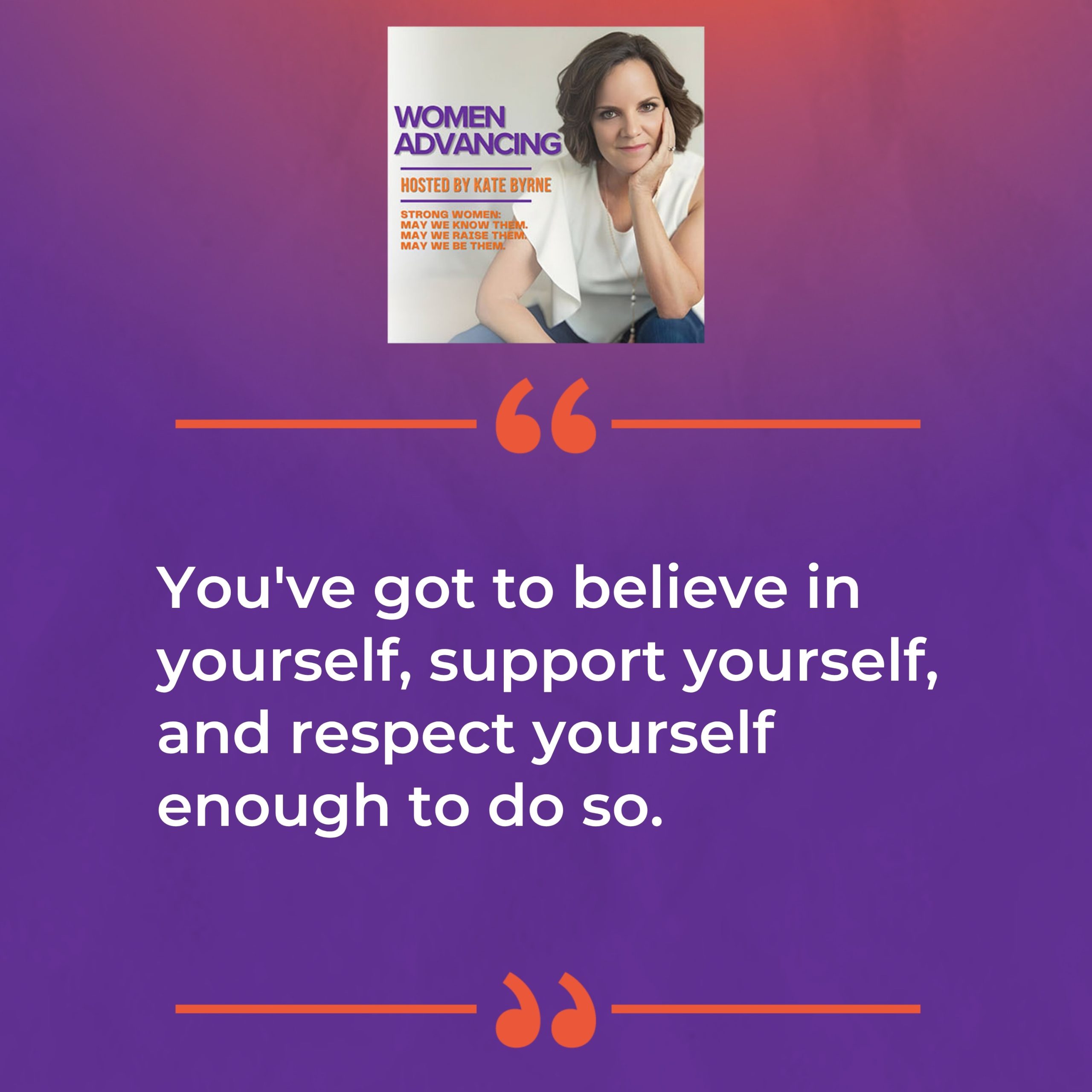
What was I afraid of? I was afraid of failure. I was afraid of being regarded as a failure because it wasn’t perfect. It doesn’t need to be perfect.
If we try for perfection, we’ll never get a product out of the lab.
Isn’t that the truth? Finally, along those lines, for those of you who are coming behind and beside, what advice would you share with this next generation of female founders?
Find people to surround yourself with who will make you the best version of you and help fill in wherever your gaps in knowledge are. That’s probably the most helpful. That’s the biggest impact of what we have done and what will make Avant Genomics become the company we want it to be.
Find people to surround yourself with that will make you the best version of you, and help fill in wherever your gaps in knowledge are. Share on XYou can’t do it alone. Find yourself a work wife.
You two, thank you so much for all of this. I’m so excited. Everyone, we have front row seats to what I know in my heart of hearts is going to be quite a magical ride. I’m not saying it’s going to be a smooth one, but the bumps are what give you a little excitement. You’re going to get it. I cannot wait to see all of the lives that are enhanced. That’s from the practitioner side and the patient side. Seriously, from the bottom of my heart, thank you so much for everything that you’re doing extraordinarily. Thanks for taking it on and having the courage to do so in your way.
Thank you so much, Kate. We enjoyed chatting with you.
We’ll be back. Believe me. I’m putting a stake in the sand. That’ll probably feel like a decade to the two of you based on what you’ve got on your plates. Seriously, thank you so much for taking the time and sharing all the many pearls.
Thank you so much.
Until next time.
—
Key Takeaways: Confidence, Imperfection, And Listening To Your Audience
Did I call it, or did I call it? It’s so heartening to see such powerhouse co-founders who are genuinely, dare I say, not in love, but in deep respect, because it holds such promise for the company that they’re building. This company, Avant Genomics, is so important. My KB takeaways for Rachelle and Renna are, first and foremost, stand up. Say something. When someone is being disrespectful, call them on it in a nice way. I know you will, but it’s so important so that they learn and they don’t do it to someone else. Also, talk about demonstrating confidence, but also support. You’ve got to believe in yourself. You’ve got to support yourself. You’ve got to respect yourself enough to do so.
Second, it does not have to be perfect. We all know that, but especially in this world, it’s better to get out there and have conversations. Learn, be curious, and don’t not do something because you don’t think it’s absolutely square on, right on, perfect. Especially when you’re frankly in a science field, there’s bound to be nightmares that follow. Lastly, clearly listen to your audience. It’s hard. That takes a lot of discipline. I’m also going to say humility.
Those are all attributes that women have in spades. Let’s put them to work. Let’s keep an eye on what these two amazing women build. They already are successful, and they’re getting us that much closer. Think about how many lives are going to be impacted. Ask yourself. What’s one thing you would do if you didn’t have to have it be absolutely perfect in your heart of hearts? What’s one thing you’d like to try? I dare you. Until next time, thanks so much for making time to tune in with us at Women Advancing.
Important Links
About Rachelle Turiello
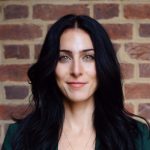 Rachelle is the co-founder and CEO of Avant Genomics, a biotech company transforming how blood samples are prepared for cancer detection. A scientist-turned-entrepreneur, Dr. Turiello developed the company’s core technology while earning her Ph.D. in analytical chemistry at the University of Virginia. She brings over a decade of experience in forensics, having worked as a crime scene investigator and DNA analyst for multiple police departments.
Rachelle is the co-founder and CEO of Avant Genomics, a biotech company transforming how blood samples are prepared for cancer detection. A scientist-turned-entrepreneur, Dr. Turiello developed the company’s core technology while earning her Ph.D. in analytical chemistry at the University of Virginia. She brings over a decade of experience in forensics, having worked as a crime scene investigator and DNA analyst for multiple police departments.
Rachelle and Renna first met at UVA during their doctoral programs, where they began developing the innovative microfluidic technology that ultimately spun out to become Avant Genomics. Today, she leads the company’s vision and growth, blending her scientific expertise with entrepreneurial drive to create rapid, highly sensitive genetic analysis tools that reimagine how clinicians and patients detect and monitor diseases.
About Renna Nouwairi
 Renna is the co-founder and COO of Avant Genomics, a Charlottesville-based biotech startup spun out of UVA research. Dr. Nouwairi earned her PhD in bioanalytical chemistry and has built her career at the intersection of chemistry, physics, and engineering, developing microfluidic technologies that translate complex science into practical solutions.
Renna is the co-founder and COO of Avant Genomics, a Charlottesville-based biotech startup spun out of UVA research. Dr. Nouwairi earned her PhD in bioanalytical chemistry and has built her career at the intersection of chemistry, physics, and engineering, developing microfluidic technologies that translate complex science into practical solutions.
Renna met her co-founder, Rachelle, while pursuing her doctoral degree at UVA, where together they began developing the technology that became Avant Genomics. Today, she leads operations and strategy, driven by a passion for building collaborative teams and creating tools that expand access to cancer detection and therapeutic monitoring.
